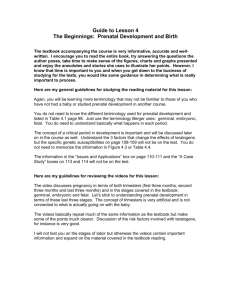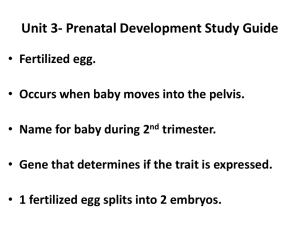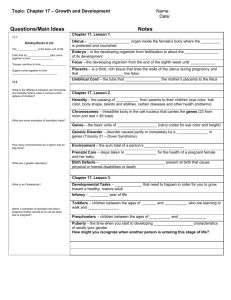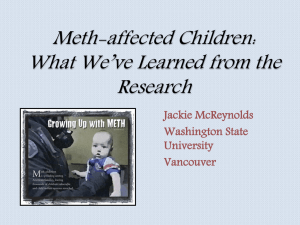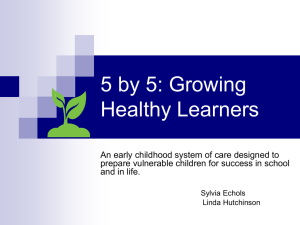4 PRENATAL DEVELOPMENT AND BIRTH LEARNING
advertisement
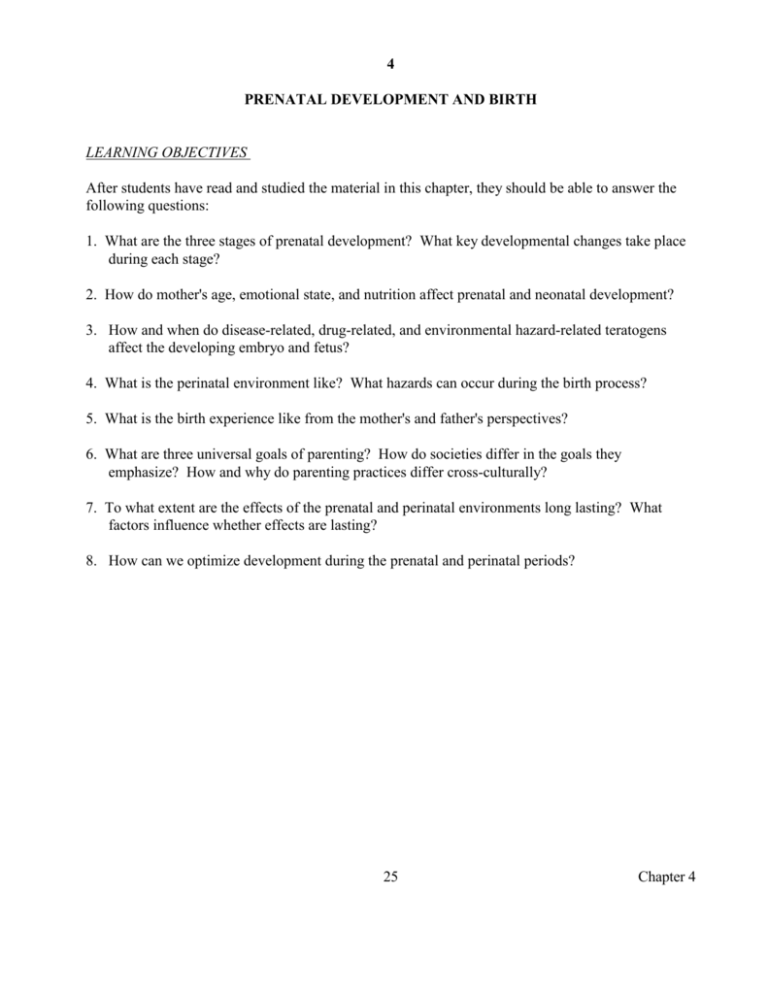
4 PRENATAL DEVELOPMENT AND BIRTH LEARNING OBJECTIVES After students have read and studied the material in this chapter, they should be able to answer the following questions: 1. What are the three stages of prenatal development? What key developmental changes take place during each stage? 2. How do mother's age, emotional state, and nutrition affect prenatal and neonatal development? 3. How and when do disease-related, drug-related, and environmental hazard-related teratogens affect the developing embryo and fetus? 4. What is the perinatal environment like? What hazards can occur during the birth process? 5. What is the birth experience like from the mother's and father's perspectives? 6. What are three universal goals of parenting? How do societies differ in the goals they emphasize? How and why do parenting practices differ cross-culturally? 7. To what extent are the effects of the prenatal and perinatal environments long lasting? What factors influence whether effects are lasting? 8. How can we optimize development during the prenatal and perinatal periods? 25 Chapter 4 CHAPTER OUTLINE I. Development in the prenatal environment Environment-- physical and social forces outside organism that influence development Prenatal time of fastest development and great environmental impact A. Prenatal stages 1. Conception and the germinal period a. conception-- egg and sperm unite to form zygote b. zygote-- single-celled fertilized egg c. prenatal development occurs in three stages i. germinal period ii. period of embryo iii. period of fetus 2. The germinal period a. 8-14 days between conception and implantation of blastula b. zygote divides to form blastula-- hollow ball of cells c. about 50% successfully implant in uterus 2. The embryonic period a. implantation to around the end of eighth prenatal week b. organogenesis-- every major organ take shape c. hormone released to stop menstruation d. differentiation into structures i. amnion-- watertight membrane surrounding ii. chorion-- membrane on outside of amnion containing villi that attach to uterine lining iii. placenta-- tissue fed by mother’s blood vessels iv. umbilical cord-- connection between embryo and mother through which nutrients and wastes are exchanged v. placental barrier-- membrane through which molecules pass e. sexual differentiation i. about seventh to eighth prenatal week ii. secretion of testosterone by male embryo stimulate male system and inhibits female system 3. The fetal period a. ninth prenatal week to birth b. second trimester i. sex and sensory organs, bones, muscles, body systems ii. age of viability-- has possibility of surviving outside uterus c. Third trimester i. rapid growth in length and weight ii. brain development-- myelination iii. infant states-- organization of behavior in waking and sleeping patterns iv. continuity between prenatal and postnatal behavior Chapter 4 26 v. contractions of uterus typically begin birth process B. The mother's state 1. Age a. ages 16-35 are "safest" b. better physical maturity and prenatal care 2. emotional condition a. prolonged, severe emotional stress may be damaging b. damage may be due to stress hormones c. presence of stress not as important as reaction to stress d. anxiety and depression may also have impact 3. Nutritional condition a. malnutrition can lead to birth defects b. prenatal malnutrition impact may lead to predisposition to adult diseases C. Teratogens 1. Teratogens-- disease, drug, or environmental agent that can harm prenatal organism 2. Generalizations concerning teratogens a. effects are worst during critical period when organs are forming b. not all embryos or fetuses are affected equally c. susceptibility is influenced by genetic makeup of mother and fetus, and the quality of the prenatal environment d. higher exposure leads to more damage f. effects determined by quality of exposure 3. Critical periods-- times when organism is highly sensitive to damage (also called sensitive periods) 4. Diseases a. rubella-- German measles i. impact includes blindness, deafness, heart defects, retardation ii. impact greatest during first prenatal month iii. immunizations critical b. syphilis i. sexually transmitted ii. impact includes blindness, deafness, heart defects, retardation iii. impact greatest late in pregnancy c. AIDS-- acquired immune deficiency disorder i. caused by HIV ii. destroys immune system iii. transmitted prenatally, perinatally, postnatally 3. Drugs a. thalidomide i. used in 1950s for relief of morning sickness ii. major impact (e.g., missing limbs) during first two prenatal months iii. banned but now being used to treat other disorders 27 Chapter 4 b. tobacco i. inhibits prenatal growth ii. passive smoke also harmful iii. increases odds of sudden infant death syndrome c. alcohol i. fetal alcohol syndrome-- cluster of symptoms (e.g., small size, distinct facial features) associated with alcohol consumption by pregnant women ii. partial FAS iii. binge drinking and continuous patterns both can have negative impact iv. genetic factors may mediate impact d. cocaine i. damage includes spontaneous abortion, sensory skill deficits, respiratory difficulty 4. Environmental hazards a. radiation can lead to mutations b. pollutants (e.g., lead) can have prenatal impact and affect father’s sperm 5. Summing up a. chemistry of prenatal environment can have major impact on development b. effects worst when organ system growing rapidly II. The perinatal environment Perinatal environment-- social and medical environment surrounding birth Birth process involves three stages of labor 1. contractions a. lasts average of 8 to 14 hours b. contractions of uterus c. dilation of cervix 2. delivery of baby a. fetus passes out of uterus b. fetus emerges from woman’s body via the vaginal opening 3. delivery of placenta A. Possible hazards 1. Anoxia-- oxygen shortage (also called asphyxia) a. umbilical cord pinched or tangled b. mucus in baby’s throat c. sedatives given to mother d. can cause mental retardation e. can cause cerebral palsy-- neurological disability inhibiting movement f. breech position (feet or buttocks first) increases risk of anoxia i. may prohibit vaginal delivery ii. may lead to cesarean section-- surgical removal of baby Chapter 4 28 2. Complicated delivery a. forceps-- salad tong-like instrument used to help extract baby b. vacuum extraction-- “suction-cup” device used to help extract baby c. cesarean section (C-section) controversial (too common?) i. can be used if baby too big or small ii. moms take longer to recover iii. used to protect physician against malpractice suits 3. Medications a. regional analgesics (epidural or spinal block) dead pain in area of body b. may reduce complications c. may make fetus less responsive 4. Identifying high-risk newborns a. Apgar test-- used to assess newborn status by assessing heart rate, color, muscle tone, respiration, and reflexes b. Apgar score of 7-10 good, 6 to 5 ok, less than 4 not good C. The mother’s experience 1. Psychological factors a. attitude, knowledge, sense of control, support impact experience 2. Cultural factors a. family size varies by culture and is affected by many factors b. Kenyan families celebrate, mom given time to recover c. Northern Indian childbirth seen as polluting and treated as shameful act d. Western societies have “medicalized” childbirth and infant mortality rates have dropped 3. Postpartum depression a. postpartum depression-- post-birth feelings of anxiety, moodiness, and depression experienced by some women in first few days after birthing b. postnatal depression-- post-birth feelings of anxiety, moodiness, and depression experienced by some women in first few months after birthing c. postnatal depression rare but serious d. most women recover from postnatal depression but it may continue to influence mother-child interactions D. The father’s experience 1. Western society fathers historically excluded from birth process 2. Impact both positive and negative III. The postnatal environment: Culture and early socialization A. Socialization-- process of acquiring beliefs and values 1. Three goals a. survival-- promote physical health b. economic-- foster skills needed for economic self-maintenance c. self-actualization-- foster sense of self-prestige and satisfaction 29 Chapter 4 2. Cross-cultural variation a. rate of infant mortality affects early treatment b. cultural belief systems determines issues like when infant spoken to c. goodness of fit-- match between infant’s behavior and culture’s demands IV. Risk and resilience A. Mitigation of negative effects of prenatal and postnatal environments B. Resilience-- ability to get back on course of normal development 1. Protective factors-- prevent problems in at-risk individuals a. personal resources-- genetic and intellectual traits b. supportive postnatal environment-- social support from environment C. Low birth weight babies 1. Weigh less than 5 1/2 pounds at birth 2. Linked to socioeconomic status 3. Associated with multiple births 4. With neonatal care many babies survive 5. In order to breath, must produce enough surfactant-- substance that prevents air sacs in lungs from sticking together 6. Having an attentive and responsive mom helps low birth weight babies achieve normal development 7. Prenatal hazards can have long-term impact but recovery is possible Chapter 4 30


